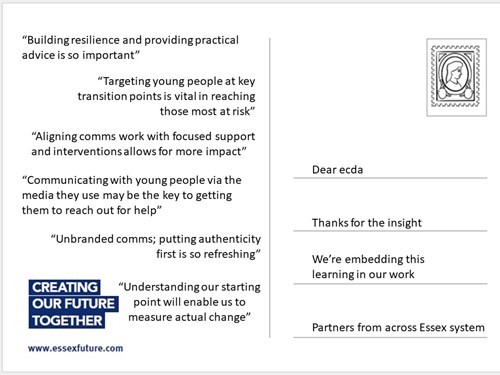Young people create campaign for change
A new campaign to help prevent the exploitation of young people in Essex has been developed with 11-16s across the county.
The behaviour change campaign, Going Country, has been informed by insight generated by the Essex Centre for Data Analytics (ecda) as part of its youth violence and vulnerability work, and has been bolstered by additional in-depth citizen research conducted by Essex County Council.
A multi-agency project led by the Violence and Vulnerability Unit, in partnership with Essex County Council, the Police Fire and Crime Commissioner, Essex Violence and Vulnerability Unit, ecda, Southend and Thurrock Councils, education, health and the voluntary sector, this is the first example of data-led multi-agency public engagement work within the county.
Young people have shaped content and participated in the video at the heart of the campaign, working with creative production agency, Raygun, to produce a film that is authentic and rooted in their world, and reflects their daily lives.
Sharing learning
ecda and Essex County Council hosted a workshop at the PFCC Conference on 13 March 2020 to share learning around this new approach to insight-led citizen engagement.
Colleagues from Police, Probation Services, Councils, Social Care and PFCC participated in a workshop to learn about the new insight generated from joining anonymised ECC and Police data on children's social care services, education and crime.
The session explored how ecda had matched what the data told us, with the experiences of 145 11-16s from 12 districts in Essex, to generate insight and form a behaviour change model that focused on 100,000 11-16 years olds in Essex considered as on the periphery of participating in gang activity.
We shared with colleagues how the insight and research enabled us to define some clear objectives for a behavioural change campaign to:
Help prevent criminal exploitation of young people by building resilience and equipping them with the knowledge and skills to understand the risks and take positive action–by:
- Increasing their knowledge and understanding, including where to turn to for help
- Giving skills and tactics to recognise and avoid/distance themselves (including asking for help)
- Highlighting personal risks of involvement to self and family (from gangs and violence)
- Drawing legality and consequences into focus to help raise importance of better choices
And we shared the content of the campaign, explaining how it was created by our audience who told us that they wanted help to:
- Rehearse and prepare decisions and figure out where they stand in advance of being in the situation
- Feel more positive and therefore be less likely to engage in risky behaviours
- Create peer to peer role models and a positive image of those who avoid risky behaviour and increase aspirations to be like them
- Challenge the social norming and reduce perceived pressure to ‘say yes’
- Provide credible reliable information that helps young people understand and appreciate the risks of each behaviour.
The content will be delivered through online channels the audience habitually use and will not carry any organisational branding.
Page last updated 18/08/21
Feedback from Essex colleagues

